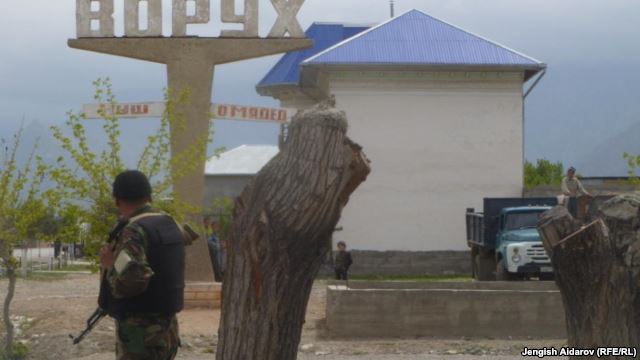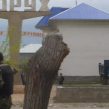
Simmering Border Conflicts Erupt Between Tajik and Kyrgyz Villagers
Publication: Eurasia Daily Monitor Volume: 10 Issue: 112
By:

Just days after the presidents of Kyrgyzstan and Tajikistan met in Bishkek to confront the periodic conflicts breaking out on their countries’ border (https://news.tj/en/news/tajik-kyrgyz-leaders-outline-main-directions-further-bilateral-cooperation), a new incident occurred between residents of Batken (Kyrgyzstan) and Isfara (Tajkistan) districts in the Ferghana Valley on May 31. Hundreds of Kyrgyz and Tajiks clashed again, leaving six people injured and several cars damaged along with widespread road closures (https://rus.ozodi.org/content/article/25003705.html).
A month earlier, on April 27, a violent incident erupted in the same border area, close to the Tajikistani enclave of Vorukh inside Kyrgyzstan’s Batken district. The conflict was sparked by the Kyrgyzstani residents’ construction of a road on what the Tajik residents claimed was Tajikistani land. The resulting clashes eventually involved around 2,000 Kyrgyz and Tajik residents living on either side of the border. A dozen were injured, including four policemen from Tajikistan; 23 individuals were taken hostage and 60 vehicles were vandalized (Fergananews.com, April 28; Avesta.tj, April 29; Ozodi.com, Gezitter.org, April 30).
The meeting of President Emomalii Rahmon of Tajikistan and his counterpart from Kyrgyzstan, Almazbek Atambayev, took place on May 27 on the sidelines of the two-day Collective Security Treaty Organization (CSTO) talks, which focused on security in Central Asia. The two leaders noted that further strengthening good neighborly and allied relations fulfills their national interests and ensures regional security and stability in the wider Central Asian region. Referencing the April 27 border incident, the two heads of state agreed that completion of the process of demarcation and delimitation of the Tajikistan-Kyrgyzstan border was of significant importance for further strengthening bilateral neighborly relations (https://news.tj/en/news/tajik-kyrgyz-leaders-outline-main-directions-further-bilateral-cooperation).
However, the demarcation and delimitation of the mutual border is not an easy task. About 80 disputed segments exist along it, and the joint commission tasked with resolving the disagreements is in a stalemate over 59 percent of the cases. The Kyrgyz Republic’s plenipotentiary representative in the Batken region, Zhenish Razakov, accused Tajikistan of dragging out the negotiations, while Tajikistani Foreign Minister Hamrohkhon Zarifi said that the issue has no quick solution, and “no one should hope to make a profit” (https://www.vb.kg/doc/228983_polpred_pravitelstva_obvinil_tadjikskyu_storony_v_sryve_delimitacii_granicy.html; https://www.ozodi.tj/content/article/24880042.html).
The border line between the two countries was mostly a symbolic formality during the Soviet period. A local chairman was able to reapportion a piece of land as a gift to a neighboring district, and the people of all nationalities were free to live anywhere in the area. Moreover the line dividing Tajikistan and Kyrgyzstan is different in Soviet maps of 1926, 1956 and 1989. Bishkek prefers a map from 1950, but Dushanbe disagrees with that cartographic boundary.
After the collapse of the Soviet Union, the latest drawn line separating the Soviet Socialist Republics of Kyrgyzstan and Tajikistan became the state border between these two newly independent countries. However, some residents of Tajikistan’s Khoja A’lo village trace the conflict in the border area to 1967. That year, a growing population and ever scarcer farmland resulted in the first open Tajik-Kyrgyz clashes in this territory over a sizeable Soviet government allotment for irrigation of new lands. Consequently, Soviet authorities apportioned 300 hectares of land to the Kyrgyz—land on which the Kyrgyz residents today want to build a road that would bypass the nearby Tajikistani enclave of Vorukh. The Tajik inhabitants of Khoja A’lo are against building this road, however (https://www.ozodi.tj/content/vorukh-enclave-after-days-of-unrest/24975892.html). To further complicate matters, according to Razakov, the Kyrgyz Republic’s plenipotentiary to Batken, the population of the Vorukh enclave is itself growing and they are “occupying all the disputed territories of Kyrgyzstan” (https://www.vb.kg/228983).
To prevent further violent incidents such as this, the presidents of Kyrgyzstan and Tajikistan ordered their governments to sign an agreement that would prohibit the construction of economic facilities along the border until the demarcation and delimitation process is completed. A similar accord was signed between local governments three years ago, but the Kyrgyz side violated it by starting to build the road that ignited the recent conflict. Razakov said he was not aware of that plan or the beginning of the road’s construction. Observers argued the accord could do nothing to prevent activity in the disputed areas by local villagers. Meanwhile, confusion stemming from the inadequately demarcated border persists (https://www.ozodi.tj/content/situation-is-getting-tense-in-vorukh/25003571.html). Tokon Mamytov, the head of Kyrgyzstan’s border guard service, believes the tensions in border areas will continue due to the long-standing disagreements of the communities over “the use of water, pasture and farmland, particularly during the sowing and harvest seasons” (https://iwpr.net/report-news/tajiks-kyrgyz-grapple-frontier-issues).
One Russian military analyst predicts that the unresolved border issue between Tajikistan and Kyrgyzstan may eventually lead to an armed conflict between the two countries, adding that the battlefield capabilities of Tajikistan’s military somewhat surpass those of the Kyrgyz Republic (https://vpk-news.ru/articles/16200). Although many Tajikistanis and Kyrgyzstanis do not believe such predictions, the recent clashes compelled the head of the Soghd province of Tajikistan, Qohir Rasulzoda, to declare that his countrymen “will not give a bit of our soil to strangers” (https://www.ozodagon.com/casia/tj/10435-rasulzoda-yak-vaab-hokamonro-ba-begonagon-namediem.html).
At the same time, the situation is being heavily politicized in Kyrgyzstan. For example, Razakov has announced that paramilitary forces that do not conform to international law can be found in Vorukh (https://www.kabar.kg/rus/politics/full/55644). Moreover, on June 6, the Youth Parliament of Kyrgyzstan organized a demonstration in front of the national legislature to demand it take notice of the border conflict in Batken. At the same time several local publications began disseminating information that Tajiks were occupying more than 1,000 square meters of Kyrgyzstan’s soil (https://www.gezitter.org/politic/20195_shilo_iz_meshka_vyilezlo_esche_v_odnom_meste/).
Furthermore, a member of Kyrgyzstan’s Parliamentary Committee on Defense and Security, Irina Karamushkina, openly warned against the “quiet penetration” of Tajiks into southern Kyrgyzstan, claiming they were buying up the houses of desperate Kyrgyzstanis (https://www.knews.kg/politics/31697_kyirgyizstan_naraschivaet_meryi_bezopasnosti_v_svyazi_s_predstoyaschim_vyivodom_voysk_ssha_iz_afganistana/). Many parliamentarians supported her, and the government has allocated 10 million soms ($210,000) to buy those houses, though the head of Kyrgyzstan’s border guard service complained that this money was not enough to buy all the houses (https://www.gezitter.org/interviews/20722_tokon_mamyitov_nachalnik_pogranichnoy_slujbyi_kr_vyidelili_10_mln_somov_na_vyikup_domov_v_batkene_kotoryie_byili_prodanyi_tadjikam/).
While the border incidents in the Ferghana Valley greatly turned up the rhetoric among politicians in Kyrgyzstan, Tajikistan has been more muted. Dushanbe is mostly concerned with maintaining good relations with Bishkek since Tajikistan is suffering pressure and transit limitation on its border with Uzbekistan—which is staunchly opposed to Dushanbe’s plans to construct the Rogun Dam upstream from it (see EDM, September 17, 2012). At the same time, Tajikistan’s experience of controversially ceding some of its territory to China in 2011 (see EDM, January 24, 2011), has made Dushanbe’s establishment much more careful in dealing with border issues. Restraint on both sides will clearly be necessary to prevent further violence or a future armed stand-off in this volatile corner of the post-Soviet space.




